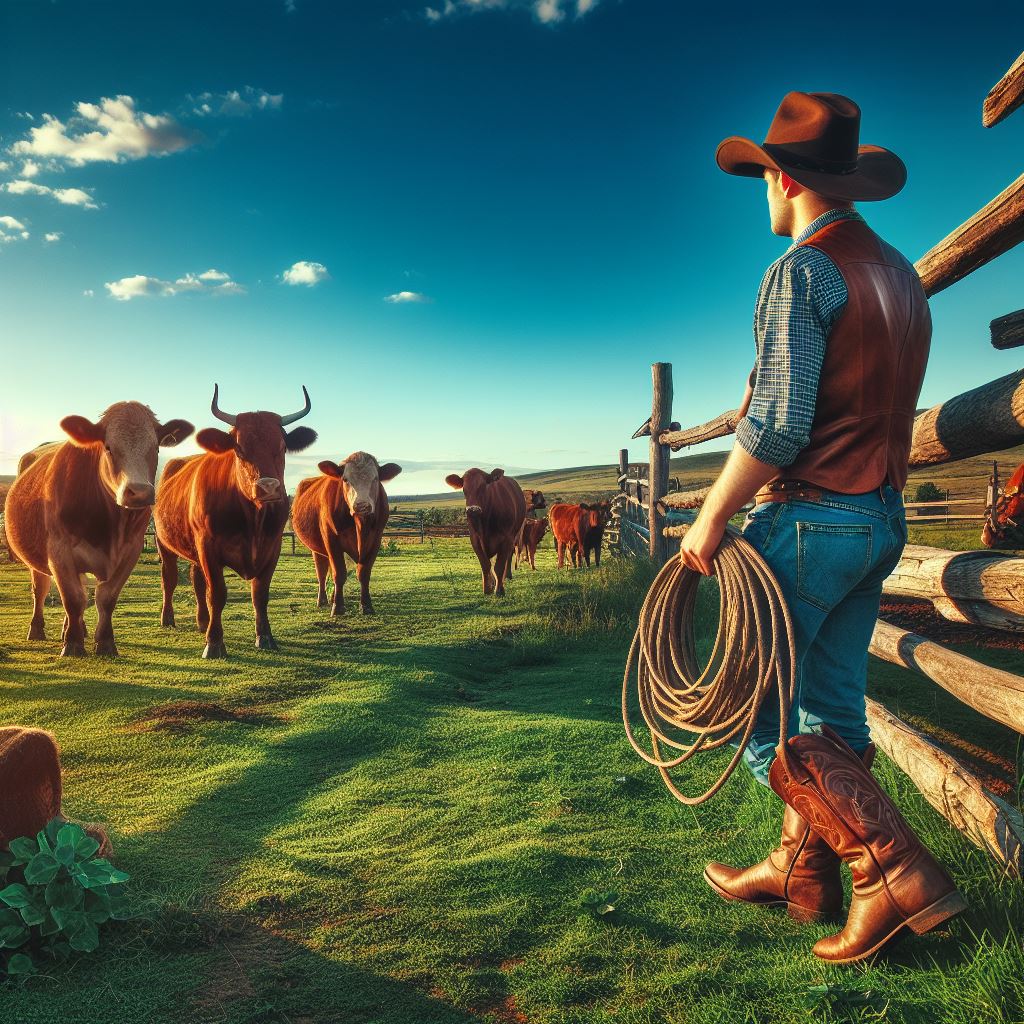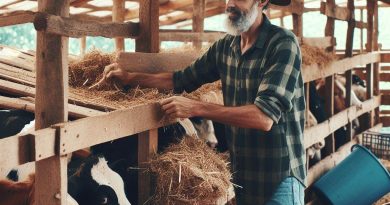Cattle Breeding 101: Essentials to Know
Last Updated on January 27, 2024
Introduction
In this blog post, we will discuss the basics of cattle breeding, its significance, and the key points to be covered in the blog post.
Cattle breeding refers to the intentional mating and reproduction of cattle for desired traits. It involves selecting suitable parents to improve the quality of the herd.
Cattle breeding is crucial for various reasons. Firstly, it helps to enhance the genetic potential of the herd, leading to increased productivity and profitability.
Secondly, it allows breeders to develop animals with desired characteristics such as improved meat quality, milk production, or disease resistance.
Additionally, it plays a vital role in maintaining the genetic diversity and sustainability of different cattle breeds.
Now, let’s provide an overview of the essentials that will be covered in the blog post.
We will discuss the importance of selecting the right breeding animals, including considerations such as breed, age, and health status.
We will also highlight the significance of proper nutrition and the essential role it plays in successful breeding programs.
Furthermore, we will delve into the various breeding methods and techniques, including natural mating, artificial insemination, and embryo transfer.
Additionally, we will touch upon the significance of monitoring and managing the reproductive health of the animals.
Lastly, we will emphasize the importance of record-keeping and data analysis for effective cattle breeding programs.
In essence, cattle breeding is a vital practice that aims to improve the quality and productivity of the herd.
By understanding the basics and following the essential guidelines, breeders can achieve their breeding objectives and contribute to the overall advancement of the cattle industry.
Selecting Breeding Stock
The success of cattle breeding depends greatly on the quality of the breeding stock chosen.
It is essential to carefully select high-quality breeding animals to ensure the production of healthy and desirable offspring.
Importance of selecting high-quality breeding stock
Selecting high-quality breeding stock is crucial for several reasons:
- Genetic improvement: Breeding stock with desirable genetic traits can help improve the overall quality of the herd over time.
- Health and productivity: Healthy and well-selected breeding animals tend to produce healthier and more productive offspring.
- Profitability: High-quality animals often command better prices, resulting in increased profitability for breeders.
Factors to consider when selecting breeding stock
There are several factors to consider when choosing breeding stock:
- Genetic traits and lineage: It is important to examine the genetic traits and lineage of potential breeding animals. Look for animals with desirable characteristics such as good growth rate, milk production, and disease resistance.
- Physical characteristics and conformation: Evaluate the physical characteristics and conformation of the animals. Look for animals with strong body structure, correct limb alignment, and good muscle development.
- Reproductive history and health records: Obtain the reproductive history and health records of the animals. This information will help assess their breeding performance and overall health.
By considering these factors, breeders can make informed decisions and carefully select breeding stock that will contribute to the overall improvement of the herd.
Understanding Reproduction
Overview of the cattle reproductive cycle
- The cattle reproductive cycle involves the process of sexual reproduction in cattle.
- It includes the stages of estrus, fertilization, gestation, and calving.
- Understanding this cycle is essential for successful cattle breeding.
- The reproductive cycle can vary among individual cows.
The estrous cycle and heat detection
- The estrous cycle is the period during which a cow exhibits signs of being in heat.
- It consists of four stages: proestrus, estrus, metestrus, and diestrus.
- Heat detection is crucial for determining the optimal time for breeding.
- Signs of heat include increased activity, mounting other cows, and clear mucus discharge.
Techniques for artificial insemination
- Artificial insemination (AI) is a common breeding technique in cattle.
- It involves depositing semen from a chosen bull into the reproductive tract of a cow.
- AI offers several advantages, including genetic improvement and disease control.
- It requires proper training and expertise to ensure successful insemination.
Natural breeding and mating considerations
- Natural breeding involves allowing cows and bulls to mate naturally.
- It is less common today but still used in some operations.
- Factors to consider include bull-to-cow ratio, breeding soundness of the bull, and mating behavior.
- Proper management is crucial to maximize conception rates in natural breeding.
In general, understanding reproduction in cattle is vital for successful breeding.
The reproductive cycle, including the estrous cycle and heat detection, plays a crucial role in determining the optimal time for breeding.
Techniques such as artificial insemination offer advantages in terms of genetic improvement and disease control.
However, natural breeding still has its place in certain operations. By considering factors such as bull-to-cow ratio and breeding soundness, breeders can maximize conception rates.
Managing Breeding Programs
In order to successfully manage a breeding program, it is crucial to develop a program that aligns with specific objectives.
Evaluation of the breeding program’s performance is a key step in determining its effectiveness. Regular assessment helps identify areas that need improvement.
Various techniques can be utilized to improve breeding efficiency. These include genetic selection, artificial insemination, and embryo transfer.
Technology and software play a vital role in modern breeding programs. These tools help track and analyze data, ensuring better decision-making.
When developing a breeding program, it is important to clearly define the objectives and goals. This allows for better planning and execution.
Regular evaluation of the breeding program’s performance helps in identifying any gaps or weaknesses that need to be addressed.
Using genetic selection techniques can help in achieving desired traits in the offspring, improving overall breeding efficiency.
Artificial insemination allows for the use of high-quality genetic material, increasing the chances of breeding success.
Embryo transfer is another technique that can be employed to maximize breeding efficiency by utilizing genetically superior embryos.
Use of technology and software in managing breeding programs
Technology has revolutionized breeding programs, making data management more efficient and accurate.
Specialized software can help in recording and analyzing data, providing valuable insights for improving breeding programs.
Using technology and software tools allows for better tracking of animals, monitoring health, and managing breeding cycles.
Additionally, technology can aid in predicting optimal mating times, ensuring successful breeding outcomes.
Managing a successful breeding program requires continuous learning and adapting to new advancements in the field.
Regularly attending workshops, seminars, and conferences can help stay updated on the latest techniques and technologies.
Collaborating with industry experts and other breeders can also provide valuable insights and guidance for improving breeding programs.
In fact, managing a breeding program involves the development of specific objectives, regular evaluation, and techniques to improve efficiency.
Utilizing technology and software enhances data management and decision-making for optimal breeding outcomes.
Continuous learning and collaboration ensure that breeders stay at the forefront of advancements in the field.
With proper management, breeding programs can achieve desired objectives and contribute to the improvement of cattle genetics.
Pregnancy and Calving
Detecting Pregnancy in Cattle
- Observing behavioral changes such as reduced appetite, increased aggression, or mounting behavior in other cows suggests a pregnant cow.
- Physical signs like a larger udder, enlarged vulva, or presence of mucus on the vulva may indicate pregnancy.
- Pregnancy can also be confirmed through palpation, where a veterinarian checks the presence of a fetus by feeling the cow’s abdomen.
Gestation Period and Signs of Calving
- The average gestation period for cows is around 283 days, but it can vary from 275 to 290 days.
- Signs of imminent calving include relaxation of the pelvic ligaments, enlarged vulva, and swelling of the udder.
- Behavioral changes like restlessness, isolation from the herd, pacing, and rearranging bedding can also indicate calving.
Preparation and Management of Pregnant Cows
- Providing proper nutrition is crucial during pregnancy to ensure the health of both the cow and the developing fetus.
- Pregnant cows should be monitored regularly, their weight and body condition scored, and any health issues addressed promptly.
- Adequate space, shelter, and clean bedding should be provided to pregnant cows to reduce stress and ensure their comfort.
Assistance and Care During the Calving Process
- It is important to create a separate, clean calving area where the cow can safely give birth without any interference.
- Regular monitoring of the cow’s progress is necessary, especially during the onset of labor and once the water breaks.
- If the cow experiences difficulties during calving, such as prolonged labor or a malpositioned calf, veterinary assistance should be sought immediately.
- Providing assistance during delivery may be required, but it should be done with caution to prevent injury to both the cow and the calf.
- After calving, the cow should be allowed to bond with her calf while ensuring proper colostrum intake for the calf’s immunity.
Essentially, understanding pregnancy and calving in cattle is essential for successful breeding and herd management.
By detecting pregnancy, knowing the signs of calving, and providing proper care, farmers can ensure the health and well-being of their cows and calves.
Regular monitoring and timely veterinary assistance play a vital role in the safe and successful delivery of calves.
Read: Starting a Poultry Farm: Essential Steps & Tips

Early Calf Management
Early calf management plays an instrumental role in setting the foundation for a healthy and productive future for the calves. Here are some key aspects to consider:
1. Importance of early calf management
Early calf management lays the groundwork for the calf’s growth and development. It significantly impacts their overall health and future productivity.
By implementing effective management practices right from birth, farmers can help their calves thrive.
2. Colostrum feeding and its benefits
Colostrum is vital for newborn calves as it provides essential nutrients and antibodies.
The first milk contains high levels of immunoglobulins, which strengthen the calf’s immune system. It is crucial to ensure that calves receive an adequate amount of colostrum within the first hours of birth.
3. Vaccination and health protocols for newborn calves
Vaccinations are essential for protecting newborn calves from common diseases. Consult with a veterinarian to develop a vaccination schedule based on the specific disease risks in your area.
Administering vaccines promptly and properly is crucial to providing adequate protection to the calves.
4. Monitoring and addressing common calf health issues
Constant monitoring of calves is crucial to identify any potential health problems early on. Monitor their behavior, appetite, fecal consistency, and respiratory rate regularly.
Promptly address any abnormalities or signs of illness by consulting with a veterinarian.
5. Addressing diarrhea (scours) in calves
Diarrhea is a common health issue in calves and can be caused by various factors such as bacterial or viral infections, inadequate nutrition, or changes in diet.
It is important to take immediate action by rehydrating the calf, providing electrolytes, and adjusting the diet accordingly.
In severe cases, consult a veterinarian for further treatment.
6. Preventing and managing respiratory issues in calves
Respiratory infections can greatly impact the health and growth of young calves. Ensure proper ventilation in calf housing and minimize exposure to extreme weather conditions.
Consult with a veterinarian to establish protocols for preventing and treating respiratory issues such as pneumonia.
7. Managing navel infections
Navel infections can occur in newborn calves if proper hygiene is not maintained.
Keep the calving environment clean and dry, and apply an antiseptic solution to the calf’s navel soon after birth.
Regularly inspect the navel for any signs of infection, such as swelling or discharge.
Generally, early calf management is crucial for the well-being of newborn calves.
Proper colostrum feeding, vaccinations, monitoring, and addressing common health issues are essential components of effective early calf management.
By prioritizing these practices, farmers can ensure the optimal growth and productivity of their calves.
Read: Aquaculture Insights: Fish Farming Tips
Genetic Improvement Techniques
In order to achieve the desired traits in cattle, genetic improvement techniques play a crucial role.
These techniques can help cattle breeders enhance the overall quality and productivity of their herds.
Let’s take a closer look at some essential genetic improvement strategies:
Overview of Genetic Improvement Strategies
- Breeding programs aim to enhance desirable traits in cattle, such as growth rate, milk production, and disease resistance.
- Genetic improvement techniques involve selecting superior animals as parents to pass on their favorable traits.
- Breeders must carefully consider factors like genetic diversity and inbreeding to maintain a healthy and robust herd.
Introduction to Genetic Selection and Crossbreeding
- Genetic selection involves choosing animals with desirable traits to reproduce and create offspring with improved characteristics.
- It helps in eliminating unwanted traits and promoting genes that contribute to better growth, fertility, and overall performance.
- Crossbreeding, on the other hand, involves mating animals from different breeds to combine their favorable traits.
- By carefully selecting suitable breeds for specific traits, breeders can create hybrid offspring with superior attributes.
Role of Genomics in Cattle Breeding
- Advancements in genomics have revolutionized cattle breeding by enabling the identification of specific genes and markers.
- Cattle breeders can now use DNA tests to evaluate an animal’s genetic potential and make informed breeding decisions.
- Genomic selection allows breeders to predict an animal’s genetic merit and select superior individuals at an early age.
- By integrating genomics into their breeding programs, breeders can expedite genetic progress and achieve desired traits more efficiently.
Importance of Record-Keeping for Genetic Improvement
- Maintaining accurate and detailed records of individual animals is crucial for effective genetic improvement.
- Records help breeders track the performance and traits of animals over generations, assisting in selection decisions.
- By analyzing historical data, breeders can identify top-performing individuals that can contribute valuable genes to the herd.
- Record-keeping also aids in monitoring health, reproduction, and pedigree information, ensuring optimal breeding outcomes.
Therefore, genetic improvement techniques are fundamental in cattle breeding to achieve desired traits and enhance herd productivity.
Breeders must implement appropriate selection and crossbreeding strategies, considering genetic diversity to maintain a robust and healthy herd.
The use of genomics has further revolutionized the industry, allowing breeders to make informed decisions and accelerate genetic progress.
Additionally, accurate record-keeping plays a vital role in tracking animal performance and optimizing breeding outcomes.
By effectively utilizing these techniques, cattle breeders can continue to improve the quality and productivity of their herds.
Read: Aquaculture Insights: Fish Farming Tips
Breeding Challenges and Solutions
Identifying common breeding challenges is crucial in maintaining a successful cattle breeding program.
By recognizing these issues, breeders can implement effective solutions and strategies to ensure optimal breeding outcomes.
In this section, we will discuss some common breeding challenges and practical solutions to overcome them.
Infertility issues and solutions
Infertility can significantly hinder the reproductive potential of cattle. It can be caused by various factors such as nutritional deficiencies, diseases, or genetic disorders. To address infertility problems:
- Conduct regular health check-ups to detect and treat any underlying diseases.
- Provide a balanced and nutritious diet to prevent nutritional imbalances.
- Ensure proper management of breeding stock, including maintaining an appropriate body condition score.
- Implement a sound vaccination and parasite control program to prevent diseases.
- Consult with a veterinarian and conduct fertility tests to identify specific issues and seek medical interventions accordingly.
Difficulties in achieving conception, and possible solutions
Failure to achieve conception can be frustrating for breeders.
Some common reasons for difficulties in achieving conception are improper heat detection, poor sire selection, or reproductive abnormalities.
The following solutions can help improve conception rates:
- Implement effective heat detection methods, such as using heat detection aids or records.
- Select high-quality and fertile sires with proven reproductive performance.
- Ensure proper nutrition and body condition of both male and female breeding stock.
- Consider using reproductive technologies, such as artificial insemination or embryo transfer, when necessary.
- Regularly monitor reproductive health and seek veterinary assistance in case of any abnormalities.
Managing inbreeding and maintaining genetic diversity
Inbreeding can lead to decreased fertility, increased incidence of genetic diseases, and reduced overall performance in cattle. To manage inbreeding and maintain genetic diversity:
- Develop and maintain a detailed pedigree record and breeding history of each animal.
- Implement a proper mating plan that avoids excessive inbreeding, ensuring suitable outcrossing.
- Consider using genetic evaluation tools and consult with breed associations to make informed breeding decisions.
- Keep a diverse pool of genetically unrelated breeding stock to maintain genetic variation.
- Regularly review and update breeding strategies based on genetic evaluations and performance records.
Ultimately, breeding challenges are inevitable in cattle breeding, but with proper identification and strategic solutions, breeders can overcome these obstacles.
By addressing issues like infertility, difficulties in achieving conception, and managing inbreeding, breeders can enhance their breeding programs’ success and promote the overall genetic improvement of their cattle.
Read: Biosecurity in Livestock Farms: Key Practices
Conclusion
This blog post covered the essential aspects of cattle breeding, emphasizing the importance of continuous learning and improvement in breeding practices.
It is crucial to stay updated with the latest techniques and advancements in the field for successful cattle breeding.
Continuous learning and improvement in cattle breeding practices is crucial for enhancing livestock productivity and sustainability.
Staying abreast of advancements in genetics, nutrition, and reproductive technologies enables breeders to optimize desirable traits, such as milk yield and disease resistance.
This ongoing education ensures the implementation of ethical and humane practices, promoting animal welfare.
Moreover, adapting to evolving environmental and market conditions is essential for maintaining the economic viability of cattle farming.
By embracing continuous learning, breeders contribute to the overall efficiency of the industry, fostering innovation, and meeting the growing demand for high-quality and sustainable animal products.
Seeking professional advice and utilizing available resources can greatly contribute to achieving desired breeding outcomes.
Remember, the journey of cattle breeding is a continuous process of refinement and development.



Cattle like humans involve not only genes, but environment. In California, we have happy cows that give the best milk, according to the California Milk Advisory Board .